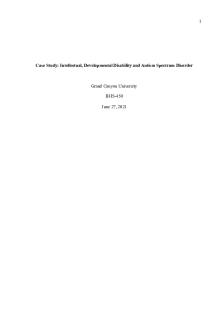Essay - Autism Spectrum Disorders in Middle & Late Childhood PDF

| Title | Essay - Autism Spectrum Disorders in Middle & Late Childhood |
|---|---|
| Author | Alexandria Carter |
| Course | Psy. Of Human Development |
| Institution | Rowan College of South Jersey |
| Pages | 5 |
| File Size | 96.3 KB |
| File Type | |
| Total Downloads | 7 |
| Total Views | 151 |
Summary
Download Essay - Autism Spectrum Disorders in Middle & Late Childhood PDF
Description
Running Head: AUTISM SPECTRUM DISORDERS IN MIDDLE & LATE CHILDHOOD
Autism Spectrum Disorders in Middle & Late Childhood Alexandria Martin Psychology of Human Development (PSY 211 – 51) Rowan College at South Jersey 15 March 2020
1
AUTISM SPECTRUM DISORDERS IN MIDDLE & LATE CHILDHOOD
2
Abstract This paper explores three published texts regarding research based on autism spectrum disorders, including autism disorder and Asperger syndrome. This analysis provides information regarding symptoms, educational methods, and causes of the disorder.
AUTISM SPECTRUM DISORDERS IN MIDDLE & LATE CHILDHOOD
3
Introduction Autism spectrum disorders, also known as pervasive developmental disorders, include autistic disorder and Asperger syndrome. Children have cognitive difficulty with processing information and will become distressed when their surrounding environment changes. Symptoms of autism spectrum disorders can include problems with social interaction, verbal communication, and nonverbal communication, and children may engage in repetitive behaviors. Autism spectrum disorders are five times more common in boys than girls (Santrock, 2020). Autism Disorder and Asperger Syndrome In 2014 the Centers for Disease Control and Prevention stated 1 in 59 children have been diagnosed with an autism spectrum disorder (Cherney, 2018). The onset of autistic disorders happens between ages one and three, with a clear diagnosis in middle to late childhood. Middle to late childhood is defined as ages six to eleven. Symptoms of autistic disorder include severe deficiencies in social relationships, abnormalities in communication, and restrictive and repetitive patterns of behavior. Asperger syndrome differs from autistic disorder since it is a milder version of the autism spectrum disorders. Children with Asperger syndrome have “relatively good language skills, milder nonverbal language problems, and a restrictive range of interests and relationships” (Santrock, 2020). Education for Children with Autism Spectrum Disorders Some children with autism spectrum disorders will also have an intellectual disability, but most have average or above average intelligence (Santrock, 2020). When teaching children that have an autism spectrum disorder, it is recommended to use simple language, give clear choices, and solve their sensory problems. Studies have shown that when these children are presented with too many options, they can easily become overwhelmed. Behavior troubles in these children can also stem from sensory discomfort. Those with autism spectrum disorders often
AUTISM SPECTRUM DISORDERS IN MIDDLE & LATE CHILDHOOD report having heightened senses, making them more sensitive to bright lights and loud sounds (“Techniques for Teaching Students with Autism Spectrum Disorder,” n.d.). Conclusion Causes of autism spectrum disorder are not definitive, but are suspected to be low birth weight, being born to older parents, genetic mutations, and other genetic disorders (Cherney, 2018).
4
AUTISM SPECTRUM DISORDERS IN MIDDLE & LATE CHILDHOOD References Cherney, K. (2018). Everything You Need to Know About Autism. Retrieved from https://healthline.com/health/autism/. Santrock, J. W. (2020). Essentials of Life-Span Development. New York: McGraw-Hill Education. Techniques for Teaching Students with Autism Spectrum Disorder. (n.d.) Retrieved from https://online.sju.edu/graduate/masters-special-education/resources/articles/techniquesfor-teaching-students-with-autism-spectrum-disorder/.
5...
Similar Free PDFs
Popular Institutions
- Tinajero National High School - Annex
- Politeknik Caltex Riau
- Yokohama City University
- SGT University
- University of Al-Qadisiyah
- Divine Word College of Vigan
- Techniek College Rotterdam
- Universidade de Santiago
- Universiti Teknologi MARA Cawangan Johor Kampus Pasir Gudang
- Poltekkes Kemenkes Yogyakarta
- Baguio City National High School
- Colegio san marcos
- preparatoria uno
- Centro de Bachillerato Tecnológico Industrial y de Servicios No. 107
- Dalian Maritime University
- Quang Trung Secondary School
- Colegio Tecnológico en Informática
- Corporación Regional de Educación Superior
- Grupo CEDVA
- Dar Al Uloom University
- Centro de Estudios Preuniversitarios de la Universidad Nacional de Ingeniería
- 上智大学
- Aakash International School, Nuna Majara
- San Felipe Neri Catholic School
- Kang Chiao International School - New Taipei City
- Misamis Occidental National High School
- Institución Educativa Escuela Normal Juan Ladrilleros
- Kolehiyo ng Pantukan
- Batanes State College
- Instituto Continental
- Sekolah Menengah Kejuruan Kesehatan Kaltara (Tarakan)
- Colegio de La Inmaculada Concepcion - Cebu















